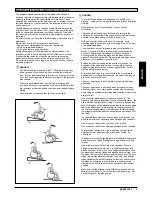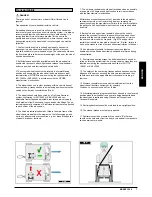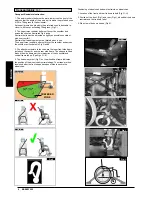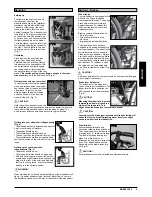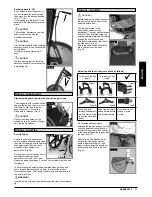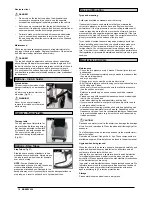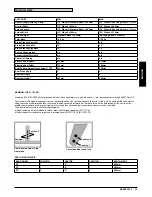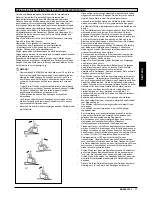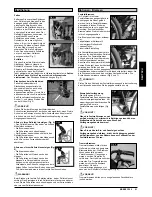
10 BREEZY 250
Options - Footplates
Footplates:
the footplates can be flipped up to make
it easier to transfer to/from the chair.
Lower leg length:
For users with longer legs, the leg
support can be lowered to the
appropriate level by using the screws (1).
Loosen the screws, push the tubes to the
desired position and then re-tighten the
screws (see section on torque). there
must always be a minimum gap of 2.5
cm between the footplates and the
ground, (Fig.10).
Footrests and Latch
the legrests can be swung inwards
under the seat sling or outwards. when
fitting the legrests, the footrests must be
pointing inwards or outwards. then
rotate the legrest inwards, until it locks
into place. to remove, pull the lever (1),
swing the footplate inwards or outwards
and then lift the legrest out. Make sure
that the legrest is locked into place
correctly, (Fig 11).
CAUTION!
the legrests must not be used to lift or to carry the wheelchair.
•
when getting on or off the wheelchair, do not use the footboards.
•
these should be flipped up beforehand or the footrest should be
swung to the outside as far as possible.
Option Elevating legrest
(Fig 12-13)
to remove, pull the lever (2), swing the footplate outwards and then lift
the legrest out.
To elevate:
take the load off the footrest and release
the hand wheel (1). Pull the footrest
upwards and adjust to the desired
height. secure the desired height by
tightening the hand wheel.
To lower:
take the load off the footrest by lifting the
lower leg and release the interlock with
the hand wheel (1) . In this way you can
swing the footrest downwards. as soon
as you have reached the desired
position, secure the interlock with
the hand wheel. you can set the lower
leg length by releasing the screws (3),
this is infinitely adjustable.
CAUTION!
keep hands clear of the adjustment
•
mechanism between, the frame and
the movable parts of the footrest
while elevating or lowering the
footrest.
the footrests should not be used to
•
lift or to carry the wheelchair.
risk of trapping fingers!
•
when moving the footrest up or down, do not put your fingers in
•
the adjusting mechanism between the moving parts of the footrest.
Adjusting the calf pad
the calf pad can be adjusted as follows:
Height: open bolt (4 Fig.13) and move the clamping piece to the
desired position. By rotating the clamping piece also the angle can be
adjusted.
Depth: open bolt (5) and move the calf pad into the desired position.
width: open bolt (5) and position the spacers behind the pad, to get the
desired position.
CAUTION!
always make sure that the fasteners are secure.
Fig. 11
1
Fig. 10
1
Fig. 12
1
2
Fig. 13
3
4
5
Castors, castor plates, forks
the wheelchair may veer slightly to the right or left, or the castors
may wobble. this may be caused by the following:
• Forward and/or reverse wheel motion has not been set properly.
• the castor angle has not been set correctly.
• castor and/or rear wheel air pressure is incorrect; the wheels do
not turn smoothly.
the wheelchair will not move in a straight line if the castors have not
been properly adjusted. castors should always be adjusted by an
authorised dealer. the castor plates must be re-adjusted, and the
wheel locks must be checked every time the rear wheel position has
been altered.
the seat height is determined by the castor and rear wheel position.
the seat height can be adjusted by altering the position of the rear
wheels and the castors
(see seat height matrix on page 14).
CAUTION!
after adjusting the seat height, all screws must be re-tightened and
the wheel lock must be readjusted.
Position of the rear wheel extension
(Fig. 14) the rear wheel extension
can be fitted behind the back tube
for greater security against tipping
over. the larger the wheelbase the
greater security against your
wheelchair tipping over.
CAUTION!
wheel locks must be adjusted to
match the new position!
Half folding back
unfolding the backrest: to put the
backrest in the upright position, push
the buttons in and lift the handles
upwards and forwards until they are
in an upright position.
keep fingers and other items away
from the folding mechanism when
the backrest is being folded to
prevent injury.
Folding the backrest:
the backrest can be folded to make
storage of the wheelchair easier.
Do not operate under load as this
may cause the mechanism to break.
to fold the backrest, stand behind
the wheelchair, push the buttons in,
(Fig. 15 and 16), and fold the
backrest down.
Options - Castors
Options - Rear Wheel Extension
Fig. 14
Options - Backrest
Fig. 15
Fig. 16
ENGLISHENGLISH





